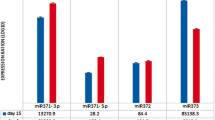Abstract
Many studies have reported that miR-302-367 cluster acts in different ways in various cell types. For instance, this cluster is shown to have a potential role in stemness regulation in embryonic stem cells (ESCs). On the other hand, this cluster inhibits the tumorigenicity of human pluripotent stem cells by coordinated suppression of CDK2 and CDK4/6 cell cycle pathways. Indeed, this cluster has a significant posttranscriptional impact on cell cycle progression. Previous reports have shown the participation of miR-302-367 cluster in cell cycle regulation of hESCs, MCF7, HepG2, and Teta-2 embryonal teratocarcinoma cells, but its effect on unrestricted somatic stem cells (USSCs) as a new source of human somatic stem cells from the umbilical cord blood remains to be elucidated. Therefore, in this study, we aimed to investigate the effect of miR-302-367 cluster on cell proliferation by MTT assay, cell cycle analysis, and colony formation assay. In addition, the expression of candidate cell cycle regulatory performance and tumor suppressor genes was determined. In this study, for the first time, we found that miR-302-367 cluster not only did not reprogram human USSCs into a pluripotent ESC-like state, but also inhibited the proliferation of human USSCs. Moreover, analyzing the cell cycle curve revealed a significant apoptotic phase upon viral introduction of miR-302-367. Our gene expression study revealed the overexpression of candidate genes after transduction of USSCs with miR-302-367 cluster. In conclusion, the controversial role of miR-302-367 in different cell types may provide better understanding for its role in stemness level and its antitumorigenicity potential in different contexts.








Similar content being viewed by others
References
Bartel DP. MicroRNAs: target recognition and regulatory functions. Cell. 2009;136(2):215–33.
Kögler G et al. A new human somatic stem cell from placental cord blood with intrinsic pluripotent differentiation potential. J Exp Med. 2004;200(2):123–35.
Trompeter H-I et al. MicroRNAs MiR-17, MiR-20a, and MiR-106b act in concert to modulate E2F activity on cell cycle arrest during neuronal lineage differentiation of USSC. PLoS One. 2011;6(1):e16138.
Barroso-del Jesus A, Lucena-Aguilar G, Menendez P. The miR-302-367 cluster as a potential stemness regulator in ESCs. Cell Cycle. 2009;8(3):394–8.
Chen D, Farwell MA, Zhang B. MicroRNA as a new player in the cell cycle. J Cell Physiol. 2010;225(2):296–301.
Johnnidis JB et al. Regulation of progenitor cell proliferation and granulocyte function by microRNA-223. Nature. 2008;451(7182):1125–9.
Kaspi H et al. miR-290-295 regulate embryonic stem cell differentiation propensities by repressing Pax6. Stem Cells. 2013;31(10):2266–72.
Rahimian A et al. Bypassing the maturation arrest in myeloid cell line U937 by over-expression of microRNA-424. Hematology. 2011;16(5):298–302.
Fallah P, et al. miR-146a and miR-150 promote the differentiation of CD133+ cells into T-lymphoid lineage. Mol Biol Rep. 2013: p. 1–7.
Cai N, Wang Y-D, Zheng P-S. The microRNA-302-367 cluster suppresses the proliferation of cervical carcinoma cells through the novel target AKT1. RNA. 2013;19(1):85–95.
Lakshmipathy U, Davila J, Hart RP. miRNA in pluripotent stem cells. Regen Med. 2010;5(4):545–55.
Lin S-L et al. MicroRNA miR-302 inhibits the tumorigenecity of human pluripotent stem cells by coordinate suppression of the CDK2 and CDK4/6 cell cycle pathways. Cancer Res. 2010;70(22):9473–82.
Cimmino A et al. miR-15 and miR-16 induce apoptosis by targeting BCL2. Proc Natl Acad Sci U S A. 2005;102(39):13944–9.
Kögler G, Sensken S, Wernet P. Comparative generation and characterization of pluripotent unrestricted somatic stem cells with mesenchymal stem cells from human cord blood. Exp Hematol. 2006;34(11):1589–95.
Adegani FJ. et al. A comparison of pluripotency and differentiation status of four mesenchymal adult stem cells. Mol Biol Rep. 2012: p. 1–11.
Suh M-R et al. Human embryonic stem cells express a unique set of microRNAs. Dev Biol. 2004;270(2):488–98.
Kluth SM, Radke TF, Kogler G. Potential application of cord blood-derived stromal cells in cellular therapy and regenerative medicine. J Blood Transfus. 2012. 2012.
Jalali H et al. Unrestricted somatic stem cells as vehicle for nerve growth factor gene transfer. Neurol Res. 2013;35(6):553–60.
Cho WJ et al. miR-372 regulates cell cycle and apoptosis of ags human gastric cancer cell line through direct regulation of LATS2. Mol Cells. 2009;28(6):521–7.
Lin, S.-L, Wu DT. Production and utilization of a novel anti-cancer drug in therapy. 2013, US Patent App. 13/964,705.
Fareh M et al. The miR 302-367 cluster drastically affects self-renewal and infiltration properties of glioma-initiating cells through CXCR4 repression and consequent disruption of the SHH-GLI-NANOG network. Cell Death Differ. 2011;19(2):232–44.
Wang L et al. MicroRNA-302b suppresses cell proliferation by targeting EGFR in human hepatocellular carcinoma SMMC-7721 cells. BMC Cancer. 2013;13(1):448.
Acknowledgments
This work was supported by a grant from the Stem Cell Technology Research Center, Tehran, Iran. The authors thank the members of their own laboratories for their helpful discussions. We are also grateful to Miss Ladan Langroudi for helping in the preparation of this manuscript.
Author information
Authors and Affiliations
Corresponding authors
Additional information
Fatemeh Jamshidi-Adegani and Lida Langroudi contributed equally to this work.
Rights and permissions
About this article
Cite this article
Jamshidi-Adegani, F., Langroudi, L., Shafiee, A. et al. Mir-302 cluster exhibits tumor suppressor properties on human unrestricted somatic stem cells. Tumor Biol. 35, 6657–6664 (2014). https://doi.org/10.1007/s13277-014-1844-x
Received:
Accepted:
Published:
Issue Date:
DOI: https://doi.org/10.1007/s13277-014-1844-x




